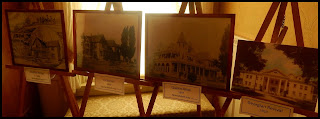Finding a campsite in a well-loved area can be a challenging task. The more popular the destination the more likely especial strategies will be necessary to ensure you have a place to sleep. Our national and state parks are seeing increasing popularity and usage as more people are discovering the great outdoors.
 |
| Find a Room with a View |
I should preface this post with the information that I generally do not make reservations at campgrounds. I can see that there are locations that this would be necessary and I have in fact encountered difficulty at a number of National Parks and a location such as Florida. But so far I have been able to work around these difficulties. (I have not yet been to Florida and may have to make some adjustments to how I travel when there.)
There seem to be three main categories of campers. Planners, Non-planners and Combination Travelers. Each category of travels will have advantages and disadvantages in their mode of travel.
Planners generally have an itinerary that covers their trip that includes reservations where they will stay each night, and sights they will see. Advanced planners may even have planned where they will eat and pre-booked sightseeing opportunities.
Non-planners (this is where I fit in) generally are spontaneous and rarely have more than a vague idea of the path of their journey. With no commitments of reservations they are able to spend as much time in a location as desired and are free to add new discovered destinations at any time.
Combination Travelers Mostly travel without reservations unless going to a high use area such a lakes near a city area or a major National Park. While I rarely make reservations, when entering a high density city or high usage area we often call ahead to find out where vacancies can be located.
We have been struggling through a combination of both in Montana near Glacier Park and another high use area, Flathead Lake, a stop-off area near West Glacier, which has resulted in a Perfect Storm where finding low cost sites has been at a premium.
But on to the Lessons...
- When in high use areas find out the check out times of campgrounds you are considering. Most of the movement out of the campgrounds will happen up to two hours prior to check out to allow campers to relocate to the next campsite. It is best to be at the entrance booth prior to check out to obtain a site.
At Many Glacier, the ranger stands at the entry gate to the campground and the wanna be campers form a line...when a site becomes available in one goes. On the morning this pic was taken there were more than 12 campers lined up hoping for a spot.
- Check on availability of private campgrounds near high use areas. Using campground apps such as AllStays or campground web sites such as freecamping.net are extremely helpful. Try to have a backup plan in all areas you are traveling. Most National Parks have private campgrounds nearby on private land to accommodate overflow travelers. But they aren’t always cheap. We called a KOA near Many Glacier in Montana that was nearly $80 before all of the extra charges....but there were other options available.
 |
| Campground outside Glacier National Park near Many Glacier |
- Consider taking a site that may not be perfect for you for one night and then do a walk about for other vacating sites for additional days. I always carry leveling blocks to accommodate less than perfect campsites.
- Talk to everyone about locations of other nearby spots that they have found available, waitresses, gas station attendants and especially other campers.
- Do not forget about other options that are available in towns such as WalMarts, Cracker Barrels, or a variety of Rest Areas and Truck Stops or other businesses that welcome travelers for a few hours of rest. Plan on patronizing these businesses to thank them for their hospitali
ty. When using these businesses for sleeping only, plan on visiting neighboring fun spots during the day while searching for your perfect spots.
Remind yourself Not every spot has to be that SPECIAL Spot!
Now if I could just find those special spots without the morning jitters and anxiety that I will find that a spot to rest each night.























































